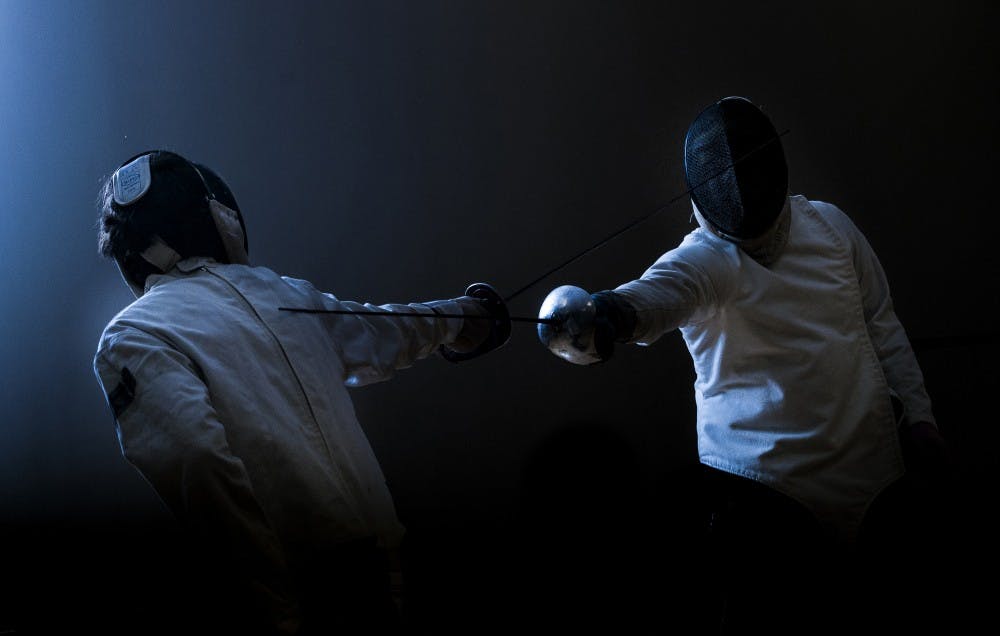LANGUAGE OF FENCING
Fencing has been a part of the Olympics since the 1896 Summer Olympics. Here are Olympic definitions of the language of fencing.
En garde: The starting position for fencing
Épée: A thrusting sword originally created from the dueling sword, similar in length to a foil but heavier, with a larger guard and a much stiffer blade
Foil: A thrusting sword with a flexible rectangular blade and a smaller guard than the épée
Rapier: A thrusting sword with an elaborate hilt and a long, slender, pointed blade, developed in the 16th century and the precursor to the épée
Sabre: The modern version of the slashing cavalry sword, similar in length and weight to the foil but able to cut with the blade as well as hit with the point
Strip or piste: The fencing field
Whites: term used to describe fencing clothes
Source: Olympic.org
The clanging of metal against metal and the rubbery squeaks of Chuck Taylor sneakers filled the room as students dueled, shuffling back and forth and brandishing their weapons.
The Ball State University Fencing Club members practiced the fencing fundamentals: wielding weapons with finesse and seeking out their opponents’ weaknesses.
“It’s the closest thing you’ll ever get to playing live chess,” Charlie Campbell, a junior interpersonal communications major, said.
MIND GAMES
Brian Koby taught fencing for 12 years before he became coach of the club in 2008.
Koby leads students through a series of warm-up routines that include stretching arms and legs and loosening joints before practice begins.
“Fencing is as much physical as it is mental,” he said.
Although fencing is multiple centuries old, modern fencing has roots in the 18th century during the Italian Renaissance, according to Fencing.net. From there, the French improved the sport and fencing schools in Spain became well-known by the 19th century.
WEAPON OF CHOICE
The club uses the three traditional weapons called foil, épée and sabre.
The foil is built for touch, being light and thin, with the chest being the only target. The épée is sturdier, built for support and stabbing while the entire body is the target. The sabre is used as a slashing weapon, but only the waist up is a target.
Weapons are designed to bend easily and distribute the force of a stab evenly throughout the blade, causing less harm to the opponent.
COMBAT WITHOUT DANGER
The fencing club plans to travel to eight different competitions this semester.
Injuries from fencing can include muscle strain or sprain, tendinitis, cartilage tears, punctures, torn tendons, fractures and lacerations. But all injuries are relatively uncommon.
The most common injuries that occur in the Ball State club are bruises, the occasional blister, puncture or small lacerations.
“It’s one of the safest contact [and] combat sports out there,” junior general studies major Elise Miller said. “We tend to have lower rates of injury than ping pong.”
According to an American Journal of Sports Medicine study of injuries in the 2008 Olympics, fencing’s injury rate was 2.5 percent. Other sports like snowboarding, soccer, taekwondo and field hockey had rates of more than 20 percent.
Fencers of all ages are required to wear a chest guard, gloves and a mask, also referred to as whites, and are completely covered with a thick canvas. However, the property surrounding the fencers can take a beating.
One such instance was when the club performed at the Olympic-themed Late Nite event.
“They set us up in a tiny room with super low ceilings, which we told them might not be the best location,” Miller said. “During the first bout, one of our members went for a cool swing at their opponent’s head and accidentally sliced open a ceiling tile.”
For more information, visit bsufc.iweb.bsu.edu.





